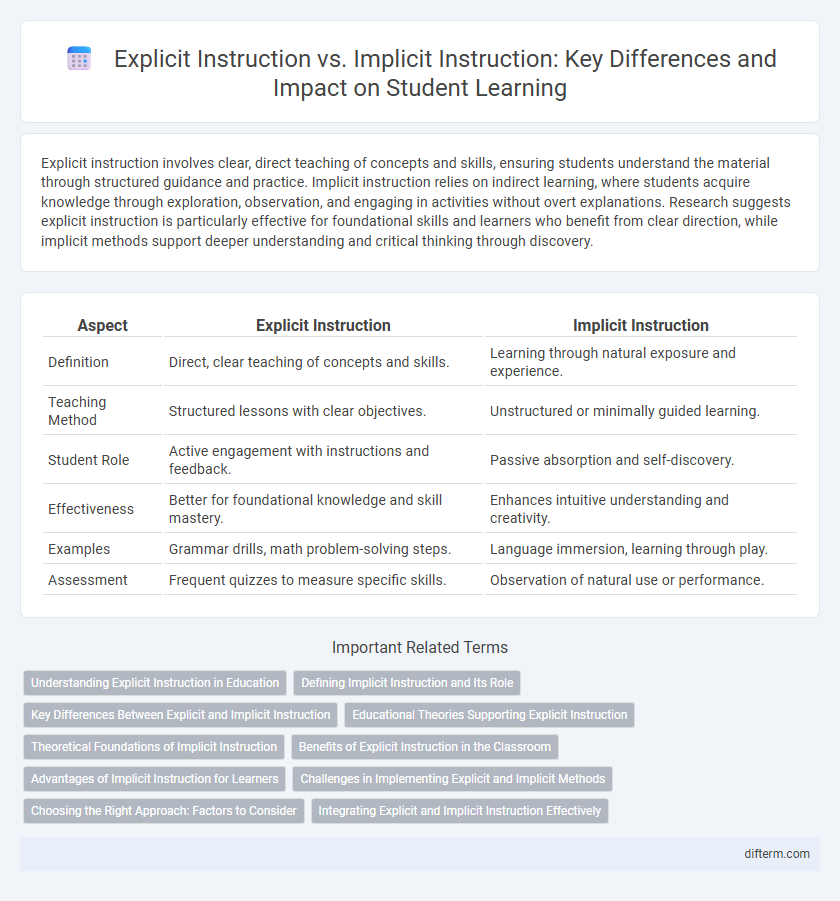Explicit instruction involves clear, direct teaching of concepts and skills, ensuring students understand the material through structured guidance and practice. Implicit instruction relies on indirect learning, where students acquire knowledge through exploration, observation, and engaging in activities without overt explanations. Research suggests explicit instruction is particularly effective for foundational skills and learners who benefit from clear direction, while implicit methods support deeper understanding and critical thinking through discovery.
Table of Comparison
| Aspect | Explicit Instruction | Implicit Instruction |
|---|---|---|
| Definition | Direct, clear teaching of concepts and skills. | Learning through natural exposure and experience. |
| Teaching Method | Structured lessons with clear objectives. | Unstructured or minimally guided learning. |
| Student Role | Active engagement with instructions and feedback. | Passive absorption and self-discovery. |
| Effectiveness | Better for foundational knowledge and skill mastery. | Enhances intuitive understanding and creativity. |
| Examples | Grammar drills, math problem-solving steps. | Language immersion, learning through play. |
| Assessment | Frequent quizzes to measure specific skills. | Observation of natural use or performance. |
Understanding Explicit Instruction in Education
Explicit instruction in education involves clear, direct teaching methods where learning objectives are clearly stated and demonstrated by the teacher. This approach emphasizes step-by-step guidance, active student engagement, and frequent checks for understanding to ensure mastery of content. Research shows that explicit instruction enhances comprehension and retention, particularly for complex skills and learners requiring structured support.
Defining Implicit Instruction and Its Role
Implicit instruction involves teaching strategies where learners acquire knowledge and skills through exposure, observation, and natural interaction rather than direct explanation. This approach fosters intuitive understanding and internalization of concepts by embedding learning within meaningful contexts, promoting deeper cognitive processing. Research highlights that implicit instruction supports language acquisition and skill development by leveraging unconscious pattern recognition and contextual cues.
Key Differences Between Explicit and Implicit Instruction
Explicit instruction involves direct teaching where learning objectives and expectations are clearly communicated, often using step-by-step demonstrations and guided practice. Implicit instruction relies on indirect learning methods such as immersion and exploration, allowing students to infer rules and concepts through context and experience. Key differences include the level of teacher control, transparency of learning goals, and the role of feedback, with explicit instruction providing structured, immediate feedback and implicit instruction fostering independent discovery.
Educational Theories Supporting Explicit Instruction
Educational theories such as Behaviorism and Cognitive Load Theory strongly support explicit instruction by emphasizing structured, clear, and systematic teaching methods that reduce cognitive overload and promote mastery of skills. Explicit instruction leverages direct guidance, modeling, and immediate feedback, aligning with Vygotsky's Zone of Proximal Development by scaffolding learner understanding effectively. Research shows this approach enhances student achievement, particularly in foundational subjects like reading and mathematics, by fostering clear connections between concepts and practice.
Theoretical Foundations of Implicit Instruction
Implicit instruction is grounded in constructivist learning theories emphasizing natural language acquisition and cognitive processing through exposure and interaction rather than direct explanation. Theoretical foundations include Vygotsky's social development theory, highlighting the role of social context and scaffolding in learning, and Krashen's input hypothesis, which posits that learners acquire language most effectively when comprehensible input is provided in meaningful contexts. This approach fosters subconscious assimilation of knowledge by embedding learning within authentic communicative experiences without overt rule presentation.
Benefits of Explicit Instruction in the Classroom
Explicit instruction enhances student understanding by providing clear, direct teaching of concepts and skills, reducing confusion and promoting mastery. It supports diverse learners, especially those with learning difficulties, by breaking down complex tasks into manageable steps. Consistent use of explicit instruction facilitates higher academic achievement and builds student confidence through structured guidance and immediate feedback.
Advantages of Implicit Instruction for Learners
Implicit instruction enhances language acquisition by mimicking natural learning environments, allowing learners to absorb grammar and vocabulary subconsciously. This method promotes deeper cognitive processing and retention through contextualized exposure rather than rote memorization. Learners develop stronger communication skills and fluency as implicit instruction emphasizes authentic interaction and meaning over explicit rules.
Challenges in Implementing Explicit and Implicit Methods
Challenges in implementing explicit instruction include ensuring teachers have the training to deliver clear, structured lessons that cater to diverse learning speeds and maintain student engagement. Implicit instruction faces difficulties in providing enough context for learners to infer rules without direct explanations, which can lead to misunderstandings or incomplete knowledge. Balancing these methods requires resources for professional development and ongoing assessment to adapt teaching strategies effectively.
Choosing the Right Approach: Factors to Consider
When choosing between explicit instruction and implicit instruction, educators should consider student learning styles, content complexity, and educational goals. Explicit instruction is effective for foundational skills and clear objectives, providing step-by-step guidance and immediate feedback. Implicit instruction suits exploratory learning environments where students develop understanding through experience and discovery, fostering critical thinking and creativity.
Integrating Explicit and Implicit Instruction Effectively
Integrating explicit and implicit instruction effectively enhances student learning by combining clear, structured guidance with immersive, contextualized experiences. Explicit instruction provides direct teaching of concepts and skills, ensuring foundational knowledge, while implicit instruction leverages natural language acquisition and discovery learning for deeper cognitive connections. Balancing both approaches supports diverse learning styles and promotes meaningful retention and application of educational content.
explicit instruction vs implicit instruction Infographic

 difterm.com
difterm.com